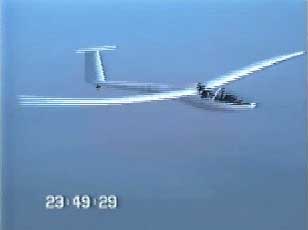Almost one year had passed between the maiden flight of works no. 1 and the completion of no. 2 – this usually takes no more than a few months. The reason for this delay were significant constructional modifications on the wings, tail and the control surfaces. These became necessary to comply with additional requirements concerning flutter resistance, which have only recently been introduced by the LBA (the German Civil Aviation Authority).
The DG-1000 is the first of the DG gliders affected by this new regulation.
These additional requirements have been stipulated by the FAA (the US Civil Aviation Authority), who found a discrepancy between the flutter regulations hitherto valid for gliders and those for commercial aircraft. The additional requirement states that the flutter resistance has to be proved with fixed control surfaces as well as with loose control surfaces. This configuration leads to completely different control frequencies from those you find on gliders with loose control surfaces, so to design the structure of the DG-1000 in a way that no resonant frequencies and therefore no theoretical fluttering can occur we had to reinforce the glider’s structure. The tail plane of the DG-1000, for instance, now has to be 4 times stronger now than would have been necessary to ensure structural integrity, and most control surfaces have to be 100 % mass-balanced.
We don’t think any of the gliders currently or previously in production comply with this new regulation. Since none of those gliders ever showed any inclination to flutter in flight, we ask ourselves whether the new requirements are really necessary. Also, it is questionable whether a glider pilot – unlike the hydraulics in a commercial aircraft – would ever hold the controls in such a way that the glider might show flutter tendencies in flight.
On the other hand it is difficult to find arguments against these new safety requirements as – at least in theory – there is a risk of fluttering. And who wants to be held responsible if anything happens?
As we all know, Wilhelm Dirks himself encountered this very problem when he testflew a new model and suddenly found himself sitting in the open air
 But what exactly is fluttering?
But what exactly is fluttering?
Let me explain it on the example of an aileron:
When you look at the cross-section of an aileron you see that the surface (and therefore also the mass) is a lot bigger behind the pivot point than in front of it – the bit on the right is bigger than the bit on the left in the picture. This means that the aileron is not balanced – if it is not connected to the control rods it will drop. All ailerons show this behavior to start with.
If you move the aileron downwards the wing will go up and the glider will start rolling around the longitudinal axis. The aileron’s inertia makes it heavier and leads to an increased deflection of the aileron. The same applies to the other aileron – the upward deflection is increased due to the inertial moment. What this means is that the inertia of non mass-balanced ailerons will increase the intended degree of aileron deflection. However, at normal flying speeds the effect of the surrounding airflow and the friction of the control rods sufficiently compensate for this. The only thing the pilot will notice is that with an increasing deflection of the ailerons the forces on the stick movement will also increase to a certain degree.
If, however, the control deflection happens very quickly or with a certain frequency (depending on aircraft type and flying speed) the interaction of airflow and the control surface’s inertia can have a rather uncomfortable result. In this case the mass and rigidity of all the components of the glider play a crucial role as any glider may start oscillating due to its elasticity and the interaction of airflow and inertia. This is particularly uncomfortable at high speeds since the effect of the airflow will increase dramatically even with very little control deflection or distortion of the wing. The oscillation can increase to a point where the glider gets overstressed and breaks up.
Mass-balancing the controls helps to avoid the negative effects of airflow and inertia in certain cases of fluttering.
This is nothing new, so the leading edges of all the controls of a glider are fitted with a mass-balance weight. This reduces the mass difference on both sides of the pivot point and eliminates the possibility of fluttering controls. Up until now everything was then fine if the test pilot could prove the flutter resistance in flight.
The new regulation, however, requires the mass-balance weights to be substantially bigger than they used to be. Therefore all production moulds for the DG-1000, which had already been completed, had to be modified. We had to build several tail planes and test them before the flutter specialist was happy. In addition we had to change the design of the controls in the wings and various other things, etc. It certainly wasn’t an easy time…
And it doesn’t stop there – the request for 100 % mass-balanced control surfaces also leads to a change in the control forces:
Control surfaces that are not fully mass-balanced support the pilot’s stick movements – the glider appears to be very light on the controls. This is great, used to be perfectly legal in the past and is done in one of the existing competition gliders, but won’t be approved for any future glider design. This means that the increased flutter resistance leads to increased control forces.
Unfortunately some pilots praise the low control forces of the competing model. But for new constructions – like the DG-1000 – these low forces just cannot realized any more because of the new rules. That is the price of safety!
The aileron forces of the DG-1001 are now very similar to the DG-800, which is very satisfactory for a two-seater. Any further reduction of the aileron forces would only be possible without fully mass-balanced controls, but as we know this is not an option anymore.
Well, the new regulation is, after all,
supposed to improve your safety.
– friedel weber und w-dirks –
– translated by Claudia Buengen –
A flutter test with the DG-300/17 of the DLR Braunschweig: FLUTTER “Der heiligen DG”
Here you can download a spectacular video showing a Flutter Test, something you normally do not see.
We are lucky to have pilots who will risk such potentially dangerous tests to give us the opportunity the better understand the Phenomena of Flutter.
The following information is important to be read to understand this video with the fluttering wing on a DG-300/17:
![]()
Dear Mr. Weber,
this DG-300/17 is a Research Plane, in comparison to the factory DG-300 is it a plane on which the wingspan was increased from 15m to 17m. The additional wingspan was added towards the wing root.
The filmed flutter with limited amplitude only occurred with a high water ballast. The too large water tanks contained more water than the allowed amount. The flutter tendency with increasing amount of water was known based on flatter calculation and static flutter tests by the DLR Institut for Aero-elastic. During these tests a small reduction within a limited speed range was discovered.
The observed flutter oscillation during this experiment of the glider in actual flight gave us the opportunity, to prove the results of the theoretical methods used. Of course it goes without saying that such high risk flight tests could only be planned and carried out by highly experienced specialists of the DLR Braunschweig.
To obtain the airworthiness certificate the water ballast was reduced to such an amount that for the normal use of this plane, for research purposes within the DLR and at the yearly IDAflieg comparison glider performance program, such Flutter cannot occur.
The film shows the flutter occurring at an airspeed between 140 and 150 km/hr during which the anti-symmetric wing bending and rotation momentum of the aileron are involved. By fastening the controls a non-linear reaction occurs , which develops a flutter with limited amplitude. Because of this, an overload and breakup of the plane does not occur.
When the airspeed by pulling on the stick, without hindering the sidewards movements of the stick, is reduced, the flutter oscillations will stop, but only when an appreciably slower airspeed is reached. This speed is the actual flutter airspeed of the plane. Flutter will start, when this airspeed is exceeded and the right disturbance influences the plane at this point.
Please Note:
All planes having an airworthiness certificate have gone through extensive static oscillation tests and flutter calculations in addition to a flight test program during which they have been checked for critical flutter behavior. Within approved operation field and its limitations as shown in the flight handbook one can be assured that no aero-elastic instabilities/flutter will occur.
Jan Schwochow
Flugabteilung des DLR (Deutsches Zentrum fuer Luft und Raumfahrt)
Braunschweig mit technisch/wissenschaftlicher Unterstützung
des Instituts für Aeroelastik des DLR in Göttingen)

Videoclip of 13 seconds / 2 MB
Translation Frank Pennauer
